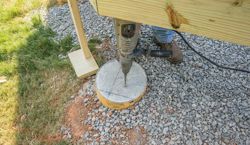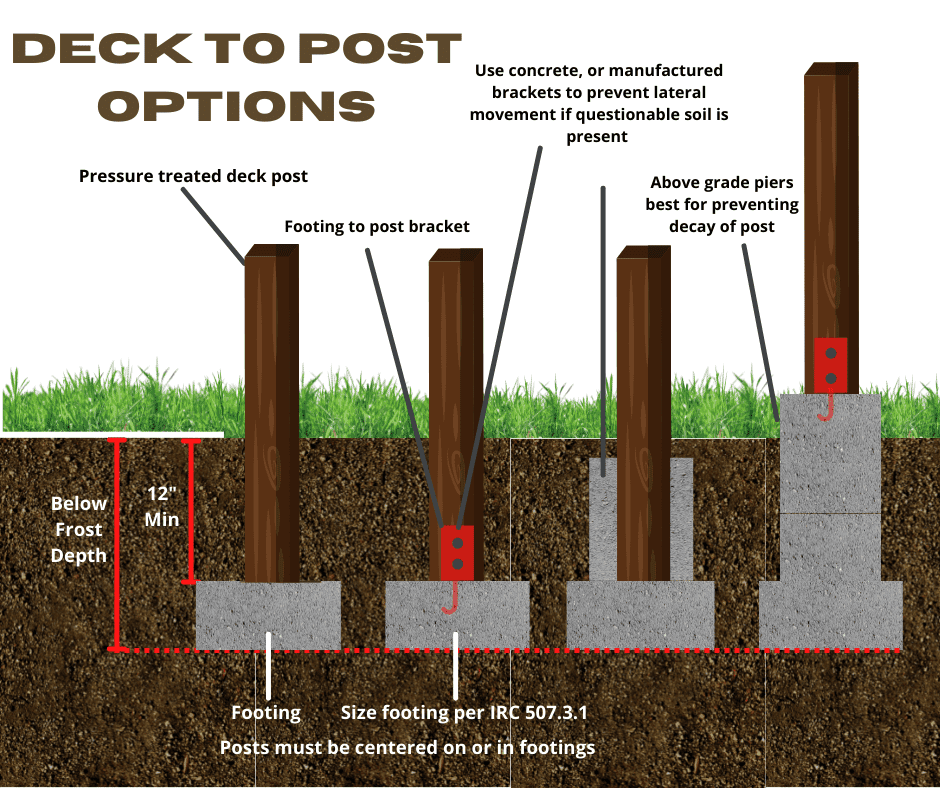Step-by-Step Deck Quality: Ensuring Stability with Appropriately Installed Deck Footings
Choosing the Right Deck Footings for Security and Longevity
The durability and safety and security of your deck depend heavily on the kind of grounds you choose, as they supply the vital assistance and security to withstand the test of time. In this discussion, we will check out the different types of deck footings, think about the important elements to consider when making a decision, and dig right into the pros and disadvantages of various options.
Kinds Of Deck Grounds
These footings consist of a cylindrical hole filled with concrete, which offers a solid structure for the deck articles. Concrete pier footings are relatively easy to set up and supply superb security, making them a preferred selection for several deck projects.
An additional sort of ground is the helical stack footing. Helical piles are steel shafts with helical plates affixed to them. These footings are installed by screwing them right into the ground, which develops a safe and secure structure for the deck. Helical heap grounds are suitable for locations with difficult soil problems, as they can be mounted in nearly any type of kind of dirt. They additionally permit simple adjustment and progressing of the deck if required.
Additionally, some contractors opt for precast concrete grounds. These footings are constructed from resilient concrete and come in numerous shapes and dimensions to fit different deck styles. Precast concrete footings are hassle-free to install and provide a steady base for the deck structure.
Finally, another choice is the post-in-anchor footing system. This kind of footing includes driving a steel anchor right into the ground and attaching it to the deck blog post. It provides adaptability in regards to placing the deck messages and is ideal for decks with lightweight frameworks.
When choosing the appropriate type of deck ground, it is vital to consider aspects such as dirt conditions, deck tons, and regional structure codes (Deck Footings). Consulting with an expert service provider or structural designer can aid guarantee the proper ground is chosen for a stable and risk-free deck
Variables to Consider When Selecting Footings
When picking the appropriate footings for a deck, it is critical to thoroughly think about different factors such as soil problems, deck load, and adherence to neighborhood building regulations. These aspects play a significant role in guaranteeing the security and longevity of the deck structure.
One of the main aspects to take into consideration is the dirt problems. The type of soil on which the deck will be developed establishes the type of footings needed. For example, decks developed on sandy or loosened dirts might call for much deeper grounds to give sufficient support and avoid settling. On the other hand, decks built on clay or expansive soils might call for grounds that can suit the dirt's tendency to expand and contract.
One more essential aspect is the deck tons. The weight of the deck, including the products utilized and any potential live lots such as furniture or events, must be considered when picking grounds. The footings have to be made to bear the weight of the deck and distribute it evenly to prevent any kind of structural concerns or failures.
Finally, adherence to regional building codes is extremely important. Building codes vary from area to region, and it is important to comply with the details demands set by the regional authorities. Deck Footings. These codes make sure that the deck is developed securely and meets the essential requirements for architectural stability and load-bearing capacity
Concrete Grounds: Cons and pros

Concrete grounds provide several advantages and downsides when made use of as the structure for a deck. On the favorable side, concrete grounds give outstanding stability and sturdiness. Concrete is a strong and Full Article rigid product that can sustain heavy tons and endure numerous climate condition. It also has a long life expectancy, making it a reliable choice for long-term use.
Another advantage of concrete footings is their convenience. They can be poured right into various forms and dimensions to suit different deck styles and configurations. Concrete grounds can be customized see this site to fit the certain needs and requirements of the deck structure.
However, there are also some downsides to making use of concrete footings. One major drawback is the cost and labor associated with their installment. Concrete footings need excavation and typically need the aid of heavy equipment. This can enhance the general expense of the deck task and might need professional help.

Helical Piers Vs. Sonotubes: Which Is Much better?
In thinking about the structure options for a deck, the comparison between helical piers and sonotubes is critical in identifying the superior option. Helical piers, likewise referred to as screw piles, are steel shafts with helical plates connected to them. They are twisted right into the ground making use of hydraulic equipment, providing a resilient and stable foundation for the deck. On the other hand, sonotubes are cylindrical forms constructed from cardboard or fiber material that are full of concrete. They are put in an opening explored the ground and provide support for the deck.
The helical plates on the piers create a strong grip with the soil, protecting against any movement or moving of the deck. Sonotubes, on the other hand, count only on the concrete filling up for security, which may not provide the very same level of strength and resistance.
In terms of installment, helical piers are relatively simpler and faster to mount contrasted to sonotubes. The hydraulic equipment utilized to turn the piers right into the ground guarantees a quick and efficient process. Sonotubes, on the other hand, require digging openings and putting concrete, which can be labor-intensive and taxing.
Furthermore, helical piers are a more functional choice. They can be used in various dirt conditions and can be changed or strengthened if needed. Sonotubes, on the other hand, might call for added support, such as rebar, in certain soil problems or areas with high load demands.
Choosing the Right Footings for Your Deck's Dimensions
For ideal structural honesty, it is important to very carefully pick the suitable grounds that straighten with the dimensions of your deck. The dimensions of your deck, including its height, width, and length, play Look At This a considerable function in figuring out the type and size of footings required.
When choosing grounds for your deck, it is very important to take into consideration the load-bearing ability of the soil. The weight of the deck, incorporated with the weight of any kind of furnishings or individuals on it, puts in a considerable pressure on the grounds (Deck Footings). Therefore, it is essential to choose grounds that can properly support this weight without changing or sinking with time.
The dimension and form of the grounds ought to also be taken into consideration. Bigger decks with higher dimensions require bigger footings to offer sufficient security and support. The form of the grounds, whether they are round or square, depends upon the design and format of the deck. Furthermore, the depth at which the grounds are installed should be figured out based upon the frost line in your area to avoid any heaving or changing due to freezing temperatures.
Verdict
To conclude, choosing the ideal deck footings is essential for guaranteeing stability and toughness. Factors such as the kind of footings, the deck's dimensions, and the pros and disadvantages of various choices should be thought about. Concrete grounds provide toughness and longevity, yet might be much more taxing and expensive to set up. Helical piers and sonotubes have their very own advantages and downsides. Ultimately, choosing the proper grounds for your deck's particular demands is crucial for a successful and resilient framework.
These footings consist of a round opening loaded with concrete, which provides a solid foundation for the deck messages. Concrete pier footings are fairly simple to install and provide superb stability, making them a popular choice for numerous deck tasks.
Precast concrete grounds are convenient to set up and offer a stable base for the deck structure.
It offers versatility in terms of positioning the deck messages and is suitable for decks with light-weight frameworks.
Concrete grounds use a number of benefits and downsides when utilized as the foundation for a deck.